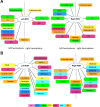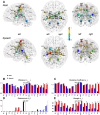Speech networks at rest and in action: interactions between functional brain networks controlling speech production
- PMID: 25673742
- PMCID: PMC4416556
- DOI: 10.1152/jn.00964.2014
Speech networks at rest and in action: interactions between functional brain networks controlling speech production
Abstract
Speech production is one of the most complex human behaviors. Although brain activation during speaking has been well investigated, our understanding of interactions between the brain regions and neural networks remains scarce. We combined seed-based interregional correlation analysis with graph theoretical analysis of functional MRI data during the resting state and sentence production in healthy subjects to investigate the interface and topology of functional networks originating from the key brain regions controlling speech, i.e., the laryngeal/orofacial motor cortex, inferior frontal and superior temporal gyri, supplementary motor area, cingulate cortex, putamen, and thalamus. During both resting and speaking, the interactions between these networks were bilaterally distributed and centered on the sensorimotor brain regions. However, speech production preferentially recruited the inferior parietal lobule (IPL) and cerebellum into the large-scale network, suggesting the importance of these regions in facilitation of the transition from the resting state to speaking. Furthermore, the cerebellum (lobule VI) was the most prominent region showing functional influences on speech-network integration and segregation. Although networks were bilaterally distributed, interregional connectivity during speaking was stronger in the left vs. right hemisphere, which may have underlined a more homogeneous overlap between the examined networks in the left hemisphere. Among these, the laryngeal motor cortex (LMC) established a core network that fully overlapped with all other speech-related networks, determining the extent of network interactions. Our data demonstrate complex interactions of large-scale brain networks controlling speech production and point to the critical role of the LMC, IPL, and cerebellum in the formation of speech production network.
Keywords: graph theoretical analysis; hemispheric lateralization; large-scale networks; resting state; speech production.
Copyright © 2015 the American Physiological Society.
Figures






Similar articles
-
The Functional Connectome of Speech Control.PLoS Biol. 2015 Jul 23;13(7):e1002209. doi: 10.1371/journal.pbio.1002209. eCollection 2015 Jul. PLoS Biol. 2015. PMID: 26204475 Free PMC article.
-
Functional connectivity of the insula in the resting brain.Neuroimage. 2011 Mar 1;55(1):8-23. doi: 10.1016/j.neuroimage.2010.11.049. Epub 2010 Nov 24. Neuroimage. 2011. PMID: 21111053
-
Functional but not structural networks of the human laryngeal motor cortex show left hemispheric lateralization during syllable but not breathing production.J Neurosci. 2009 Nov 25;29(47):14912-23. doi: 10.1523/JNEUROSCI.4897-09.2009. J Neurosci. 2009. PMID: 19940187 Free PMC article.
-
Structure and function of complex brain networks.Dialogues Clin Neurosci. 2013 Sep;15(3):247-62. doi: 10.31887/DCNS.2013.15.3/osporns. Dialogues Clin Neurosci. 2013. PMID: 24174898 Free PMC article. Review.
-
The dynamical balance of the brain at rest.Neuroscientist. 2011 Feb;17(1):107-23. doi: 10.1177/1073858409354384. Epub 2010 Dec 31. Neuroscientist. 2011. PMID: 21196530 Free PMC article. Review.
Cited by
-
The Functional Connectome of Speech Control.PLoS Biol. 2015 Jul 23;13(7):e1002209. doi: 10.1371/journal.pbio.1002209. eCollection 2015 Jul. PLoS Biol. 2015. PMID: 26204475 Free PMC article.
-
Stability of Network Communities as a Function of Task Complexity.J Cogn Neurosci. 2016 Dec;28(12):2030-2043. doi: 10.1162/jocn_a_01026. Epub 2016 Aug 30. J Cogn Neurosci. 2016. PMID: 27575646 Free PMC article.
-
New Developments in Understanding the Complexity of Human Speech Production.J Neurosci. 2016 Nov 9;36(45):11440-11448. doi: 10.1523/JNEUROSCI.2424-16.2016. J Neurosci. 2016. PMID: 27911747 Free PMC article. Review.
-
Inner versus Overt Speech Production: Does This Make a Difference in the Developing Brain?Brain Sci. 2020 Dec 5;10(12):939. doi: 10.3390/brainsci10120939. Brain Sci. 2020. PMID: 33291489 Free PMC article.
-
Sexual Dimorphism Within Brain Regions Controlling Speech Production.Front Neurosci. 2019 Jul 30;13:795. doi: 10.3389/fnins.2019.00795. eCollection 2019. Front Neurosci. 2019. PMID: 31417351 Free PMC article.
References
-
- Ackermann H. Cerebellar contributions to speech production and speech perception: psycholinguistic and neurobiological perspectives. Trends Neurosci 31: 265–272, 2008. - PubMed
-
- Ackermann H, Mathiak K, Ivry RB. Temporal organization of “internal speech” as a basis for cerebellar modulation of cognitive functions. Behav Cogn Neurosci Rev 3: 14–22, 2004. - PubMed
-
- Ackermann H, Mathiak K, Riecker A. The contribution of the cerebellum to speech production and speech perception: clinical and functional imaging data. Cerebellum 6: 202–213, 2007. - PubMed
-
- Baddeley A. Working memory: looking back and looking forward. Nat Rev Neurosci 4: 829–839, 2003. - PubMed
Publication types
MeSH terms
Grants and funding
LinkOut - more resources
Full Text Sources
Other Literature Sources
Medical

